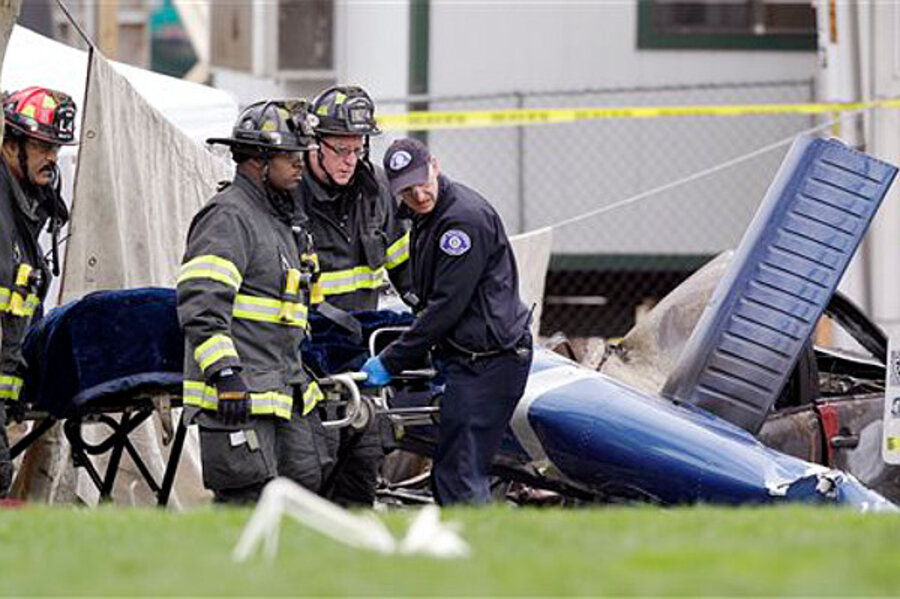KOMO crash: Investigators comb scene of deadly KOMO-TV helicopter crash
Loading...
| SEATTLE
A news helicopter crashed into a street and burst into flames Tuesday near Seattle's Space Needle, killing both people on board, badly injuring a man in a car, and sending plumes of black smoke over the city during the morning commute.
The chopper was taking off from a helipad on KOMO-TV's roof when it went down at a downtown intersection and hit three vehicles, starting them on fire and spewing burning fuel down the street.
Kristopher Reynolds, a contractor working nearby, said he saw the helicopter lift about 5 feet off the low-rise building before it started to tilt. The chopper looked like it was trying to correct itself when it took a dive.
"Next thing I know, it went into a ball of flames," Reynolds said.
Witnesses also reported hearing unusual noises coming from the helicopter as it took off after refueling, said Dennis Hogenson, deputy regional chief with the National Transportation Safety Board in Seattle. They said the aircraft then rotated before it crashed near the Seattle Center campus, which is home to the Space Needle, restaurants and performing arts centers.
Mayor Ed Murray noted the normally bustling Seattle Center was relatively quiet at the time. Had it been a busier day, "this would have been a much larger tragedy," he said.
In response to the crash, the city will review its policies about permitting helicopter pads, Murray said.
Investigators worked to document the scene and will examine all possibilities as they determine what caused the crash, Hogenson said. A preliminary analysis is expected in five days, followed by a fuller report with a probable cause in up to a year.
KOMO identified the pilot as Gary Pfitzner, of Issaquah. Also killed in the crash was Bill Strothman, a former longtime KOMO photographer. Both men were working for Cahokia, Ill.-based Helicopters Inc., which owned the Eurocopter AS350. The aircraft was leased jointly by KOMO and KING-TV.
Firefighters who arrived at the scene before 8 a.m. found a "huge black cloud of smoke" and two cars and a pickup truck engulfed in flames, Seattle Fire Department spokesman Kyle Moore said.
Fuel running down the street also was on fire, and crews worked to stop it before it entered the sewer, Moore said.
An injured man managed to free himself from a burning car and was taken to Harborview Medical Center, Moore said. The man was on fire, and KOMO reported that one of its building security guards, Brian Post, ran toward the fire to help.
"I used my hand at first and then his jacket to get the flames out," Post, a former police officer, told the station.
Richard Newman, 38, suffered burns on his lower back and arm, covering up to 20 percent of his body, hospital spokeswoman Susan Gregg said. He was in serious condition in the intensive care unit and likely will require surgery, she said.
Two others who were in vehicles that were struck by the helicopter were uninjured. One of them, a woman, went to a police station and talked to officers, while a man from the pickup walked to a nearby McDonald's restaurant. Police later located him unhurt.
Murray said the crash site could be closed for three to five days while officials with the NTSB and Federal Aviation Administration probe what happened. Only the helicopter's blue tail end could be identified among the wreckage strewn across the street.
KOMO news anchor Dan Lewis said it wasn't the regular KOMO helicopter but a temporary replacement for one that is in the shop for an upgrade.
KOMO is a block from the Space Needle and is surrounded by high-rise office and apartment buildings. Workers at the station rushed to the window when they heard the crash. KOMO reporters were then in the position of covering their colleagues' deaths.
One of them, Denise Whitaker, said on the street shortly after the crash: "It is definitely a tragic scene down here. It is a difficult time for all of us this morning."
Lewis described Strothman as someone "who really knew how his pictures could tell a million words."
"He was just a true gentleman," Lewis said on the air. "We're going to miss you guys. And thanks so much for all that you gave to us."
The Strothman family said in a statement that the former KOMO photographer was a "great man, a kind soul, a devoted husband, a loving father and brother."
The Seattle Monorail, which runs about 50 yards away, was operating Tuesday morning and passed the scene about 15 seconds before the crash happened, said Thomas Ditty, the monorail's general manager.
Other cities have experienced helicopter crashes as TV stations rush to cover the news from above major cities.
Two news helicopters collided in midair in Phoenix in 2007 as the aircraft covered a police chase, sending fiery wreckage plummeting onto a park. Four people in the helicopters were killed.
The crash prompted changes at the stations in how they operated their helicopter crews.
Associated Press writers Doug Esser and Donna Gordon Blankinship contributed to this report.
Copyright 2014 The Associated Press. All rights reserved. This material may not be published, broadcast, rewritten or redistributed.







